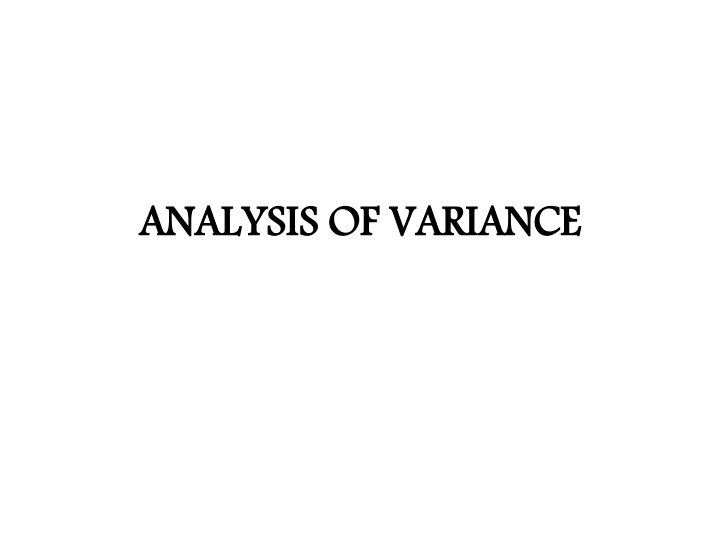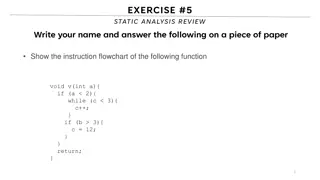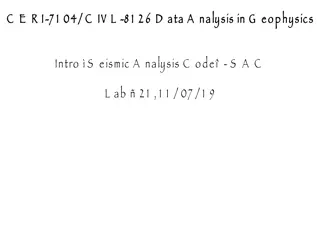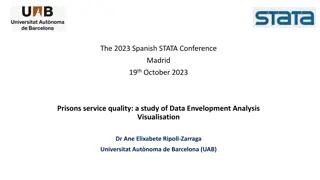
Analysis of Variance (ANOVA) in Statistical Analysis
Learn about Analysis of Variance (ANOVA) which helps in determining if changes in independent variables lead to changes in the mean response. Explore the concepts of one-way ANOVA, two-way ANOVA, higher order ANOVA, and statistical testing methods in ANOVA models.
Download Presentation

Please find below an Image/Link to download the presentation.
The content on the website is provided AS IS for your information and personal use only. It may not be sold, licensed, or shared on other websites without obtaining consent from the author. If you encounter any issues during the download, it is possible that the publisher has removed the file from their server.
You are allowed to download the files provided on this website for personal or commercial use, subject to the condition that they are used lawfully. All files are the property of their respective owners.
The content on the website is provided AS IS for your information and personal use only. It may not be sold, licensed, or shared on other websites without obtaining consent from the author.
E N D
Presentation Transcript
ANALYSIS OF VARIANCE ANALYSIS OF VARIANCE
In this Lecture we study whether changes in the independent variables cause changes in the mean response and we analyze the data using a method known as analysis of variance (or ANOVA). The technique of ANOVA consists of partitioning the total sum of squares into component sum of squares due to different factors and the error. For instance, suppose there are Q factors. Then the total sum of squares (SST) is partitioned as SST = SSA + SSB + + SSQ + SS Error, where SSA, SSB, ..., and SSQ represent the sum of squares associated with the factors A, B, ..., and Q, respectively.
If the ANOVA involves only one factor, then it is called one-way analysis of variance. Similarly if it involves two factors, then it is called the two-way analysis of variance. If it involves more then two factors, then the corresponding ANOVA is called the higher order analysis of variance. We only treat the one-way analysis of variance. 20.1. One-Way Analysis of Variance with Equal Sample Sizes The standard model of one-way ANOVA is given by ???= ??+ ??? ??? ?=1,2, ,? where m 2 and n 2. In this model, we assume that each random variable ???~?(??,?2) ??? ? = 1,2, ,? ,?=1,2, ,?, ,? = 1,2, ,?.
Theorem 20.1. Suppose the one-way ANOVA model is given by the pervious equation where the ??? s are independent and normally distributed random variables with mean zero and variance ?2for i= 1, 2, ...,mand j= 1, 2, ..., n. Then the MLE s of the parameters iand ?2of the model are given by ??= ?? 1 ?2= ????? 1 ? ?=1 ? ? ?=1 ?(??? ?? )2is ???, ???= ?=1 Where ?? = the within samples sum of squares.
Lemma 20.1. The total sum of squares is equal to the sum of within and between sum of squares, that is ???= ???+ ???, where ? ? (?? ? )2 ???= ?=1 ?=1 We will be interested in testing the null hypothesis Ho: 1 = 2 = = m = against the alternative hypothesis Ha: not all the means are equal. Hois rejected whenever the test statistics F satisfies ???? 1 where ? is the significance level of the hypothesis test and??(? 1, ?(? 1)) denotes the 100(1 ?) percentile of the F-distribution with m 1 numerator and nm mdenominator degrees of freedom. ? = ??? ?(? 1)> ??(? 1, ?(? 1))
??? = ??? + ??? = +
Where: j = particular member of treatment level i = a treatment level m = number of treatment levels n = number of observation s in a given treatment level ???= individual value ?.. = grand mean ??. = mean of a treatment group or level ( column mean) N: TOTAL NUMBER OF OBSERVATIONS
The various quantities used in carrying out the test described in Theorem 20.3 are presented in a tabular form known as the ANOVA table. Source of variation Sums of squares Degree of freedom Mean Squares F-statistics F ??? ? 1 ??? ? 1 Between ???= ? =??? ??? ??? ??? ?(? 1) Within ???= ?(? 1) ??? Total nm-1 If the value of the test statistics is F =?, then the p-value is defined as p value = P(F(m 1, m(n 1)) ?).
The ANOVA is based on the following three assumptions: (1) Independent Samples: The samples taken from the population under consideration should be independent of one another. (2) Normal Population: For each population, the variable under consideration should be normally distributed. (3) Equal Variance: The variances of the variables under consideration should be the same for all the populations.
Example 20.1. The data in the following table gives the number of hours of relief provided by 5 different brands of headache tablets administered to 25 subjects experiencing fevers of 38 C or more. Perform the analysis of variance and test the hypothesis at the 0.05 level of significance that the mean number of hours of relief provided by the tablets is same for all 5 brands.
Tablets A B C D F 5 4 8 6 3 9 7 8 6 9 3 5 2 3 7 2 3 4 1 4 7 6 9 4 7
Answer: we compute the sum of squares SSW, SSB and SST as SSW = 57.60, SSB = 79.94, and SST = 137.04. The ANOVA table for this problem is shown below. Source of variation Sums of squares Degree of freedom Mean Squares F-statistics F Between 79.94 4 19.86 6.90 Within 57.60 20 2.88 Total 137.04 24
At the significance level ? = 0.05, we find the F-table that ?0.05(4, 20) = 2.8661. Since 6.90 = F > ?0.05(4, 20) = 2.8661 we reject the null hypothesis that the mean number of hours of relief provided by the tablets is same for all 5 brands. Note that using a statistical package like MINITAB, SAS or SPSS we can compute the p-value to be p value = P(F(4, 20) 6.90) = 0.001. Hence again we reach the same conclusion since p-value is less then the given ? for this problem. See example 20.2. page 627.






















